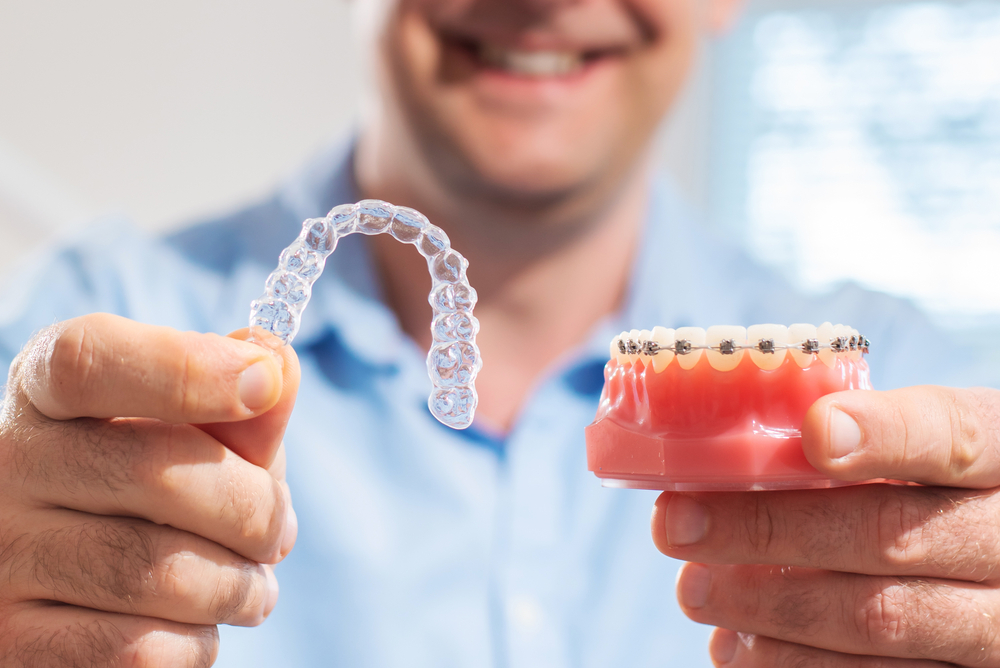When it comes to straightening your teeth and achieving that perfect smile, you have options. Traditional braces have been the go-to solution for decades, but in recent years, Invisalign has gained significant popularity. Both options have their merits, but which one is right for you? In this article, we’ll explore the key differences between Invisalign and braces, considering various aspects to help you make an informed decision.
When considering orthodontic treatment, the choice between Invisalign and braces is a significant decision. Traditional braces have stood the test of time and continue to be effective in straightening teeth. However, Invisalign’s modern approach, with its clear aligners and convenience, has garnered a considerable following. Your decision should be based on your specific needs, comfort preferences, and lifestyle.
How To Choose Between Invisalign and Braces

1. Aesthetics: Invisibility Matters
One of the most significant differences between Invisalign and braces is the aesthetics. Invisalign is virtually invisible, as it consists of clear, plastic aligners that sit snugly over your teeth. Most people won’t even notice you’re wearing them. On the other hand, traditional braces use metal brackets and wires, which can be quite noticeable and may make some individuals feel self-conscious.
2. Comfort and Convenience: A Breath of Fresh Air
Invisalign aligners are made from a smooth, comfortable plastic material, and they can be removed for eating, drinking, and oral hygiene routines. This means you can enjoy your favourite foods without restrictions and maintain excellent oral health with ease. Braces, on the other hand, involve brackets and wires that can cause discomfort, soreness, and even mouth ulcers. They also require more diligent cleaning efforts.
3. Duration of Treatment: Faster Results with Invisalign
Invisalign often delivers faster results compared to braces. The average treatment time with Invisalign is around 12 to 18 months, while braces can take 18 to 36 months or longer. If you’re looking for a quicker path to straighter teeth, Invisalign may be the way to go.
4. Effectiveness: Precision Matters
Invisalign uses advanced technology to precisely plan the movement of your teeth, allowing for highly predictable results. While braces are also effective, Invisalign’s custom-made aligners provide a more controlled and accurate approach to tooth alignment.
5. Maintenance: Simplicity vs. Complexity
Maintaining good oral hygiene with Invisalign is straightforward. You remove the aligners to brush and floss your teeth as you normally would, reducing the risk of plaque buildup and gum problems. Braces, however, require special tools for cleaning between wires and brackets, which can be time-consuming and cumbersome.
6. Adjustments: Hassle-Free vs. Regular Appointments
With Invisalign, you’ll have fewer orthodontist appointments since you change your aligners at home approximately every two weeks. Braces require regular visits to tighten the wires and make adjustments, which can be inconvenient and may cause discomfort.
7. Dietary Freedom: Enjoy What You Love
Invisalign allows you to eat your favourite foods without restrictions because you can remove the aligners before meals. With braces, you need to avoid certain foods that can damage the brackets and wires, like sticky candies and hard nuts.
8. Speech: Maintain Clarity
Invisalign aligners don’t affect your speech significantly. Braces may cause temporary speech difficulties, as your tongue and mouth adapt to the presence of metal components.
9. Cost: Budget Considerations
While Invisalign may initially seem more expensive than braces, it’s essential to factor in the long-term advantages, including shorter treatment duration, fewer orthodontist visits, and lower maintenance costs. In many cases, Invisalign’s cost is competitive with traditional braces.
10. Suitable for All Ages: Options for Everyone
Invisalign is suitable for both teenagers and adults. The clear aligners provide a discreet option for individuals of all ages who want to achieve a straighter smile. Braces are more commonly associated with younger individuals.
In the comparison between Invisalign and braces, it’s evident that Invisalign offers several advantages. From aesthetics and comfort to speed, precision, and convenience, Invisalign takes the lead in many categories. While braces are still a valid option for some cases, Invisalign’s versatility, effectiveness, and overall patient experience make it a compelling choice for those seeking a more discreet and comfortable path to a beautifully aligned smile.
Ultimately, the decision between Invisalign and braces will depend on your unique needs and preferences, but Invisalign has certainly become a top choice for many. It is always best to discuss your options with a qualified dental professional like Angel Dental Care which is a boutique dental practice in Sydney’s south-west suburb of Picton. They specialise in Invisalign braces as an alternative teeth straightening treatment to traditional braces for kids, teens and adults.
What Is The Cost Difference Between Invisalign And Traditional Braces

The cost of Invisalign and traditional braces in Australia can vary depending on several factors, including the complexity of your orthodontic case, the location of your orthodontist, and any additional services required. Here’s a general overview of the cost differences:
Invisalign:
Mild Cases: For simple, mild orthodontic issues, Invisalign may cost between $4,000 and $6,000 in Australia.
Moderate Cases: More complex cases with moderate alignment issues can range from $6,000 to $9,000.
Complex Cases: For severe or complex cases, Invisalign costs can exceed $10,000.
Please keep in mind that these are approximate cost ranges, and the actual cost can vary based on location and individual circumstances. Invisalign often includes the cost of the initial consultation, aligners, follow-up appointments, and any necessary refinements. However, it’s essential to discuss the specific cost breakdown with your chosen orthodontist.
Traditional Braces:
Metal Braces: Traditional metal braces typically range from $6,000 to $9,000, depending on the complexity of your case and the orthodontist’s fees.
Ceramic Braces: Clear or ceramic braces are a more aesthetic option but can be slightly more expensive, ranging from $7,000 to $10,000 or more.
Braces’ cost often includes the initial consultation, braces placement, regular adjustments, and the removal of braces. Retainers after treatment may also be an additional cost.
It’s important to consult with an orthodontist in your area to get a precise estimate based on your specific needs and circumstances. Many orthodontic practices offer payment plans to help make orthodontic treatment more affordable and manageable for patients. Additionally, private health insurance in Australia may cover a portion of the cost, so it’s worth checking your policy for orthodontic coverage.
What Is The Level Of Discomfort Or Pain With Both Options?

The level of discomfort or pain experienced during orthodontic treatment with braces or Invisalign can vary from person to person and often depends on individual sensitivity and the specific treatment plan. Here’s a general comparison of the discomfort associated with each option:
Braces:
Initial Discomfort: When braces are first put on or adjusted, there is usually some discomfort. You may feel soreness, pressure, or tenderness in your mouth for a few days after each adjustment.
Irritation: Brackets and wires can sometimes cause irritation to the cheeks, lips, and tongue, especially as your mouth adjusts to their presence. Orthodontic wax can be used to alleviate this.
Diet Restrictions: With braces, there are dietary restrictions, and you must avoid certain foods that can damage the braces or get stuck in them.
Invisalign:
Initial Discomfort: When you start a new set of Invisalign aligners, you may experience some initial discomfort or pressure as your teeth adjust to the new aligners. This discomfort is typically milder than the pain associated with braces.
Speech Adjustments: Some people may experience minor speech adjustments when wearing Invisalign aligners initially, but this usually improves quickly.
No Dietary Restrictions: With Invisalign, there are no dietary restrictions because you can remove the aligners when eating. This can be more comfortable for many individuals.
It’s important to note that the pain or discomfort associated with orthodontic treatment tends to be temporary. Over-the-counter pain relievers and orthodontic wax can help alleviate any discomfort. As your treatment progresses, both braces and Invisalign tend to become less bothersome, and most individuals adapt to them.
Many people find Invisalign to be less painful or uncomfortable than traditional braces, especially during the initial stages of treatment. However, individual experiences can vary, and the level of discomfort should not be the sole factor in your decision. The choice between braces and Invisalign should be based on your specific orthodontic needs, preferences, and lifestyle. It’s essential to discuss your concerns and treatment options with an orthodontist who can provide personalised advice based on your case.
The Difference Between Invisalign and Braces: What Are You Going To Choose?
When it comes to choosing between Invisalign and traditional braces, it’s evident that both options have their merits. However, it’s equally clear that Invisalign offers a compelling set of advantages, particularly in terms of aesthetics, comfort, and convenience. Its discreet appearance, shorter treatment duration, and ease of maintenance make it an attractive choice for many individuals seeking orthodontic treatment. On the other hand, traditional braces, with their proven track record, remain a reliable option for those with complex orthodontic needs.
Your decision should hinge on what matters most to you – whether it’s a subtle treatment approach, faster results, or your specific orthodontic requirements. Ultimately, consult with a qualified orthodontist who can provide tailored guidance based on your unique case and preferences. Whichever path you choose, remember that the end goal is the same: a beautifully aligned smile and improved oral health, and both Invisalign and braces can help you achieve that. To discuss your needs further get in touch with Angel Dental Care today!!

